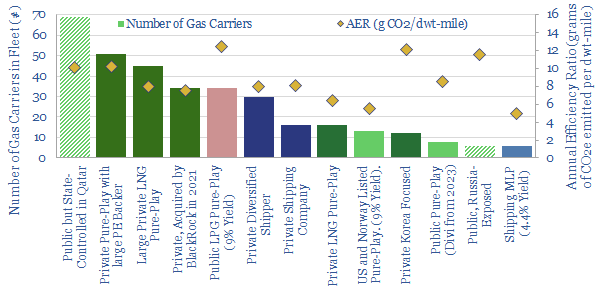This data-file is a screen of LNG shipping companies, quantifying who has the largest fleet of LNG carriers and the cleanest fleet of LNG carriers (i.e., low CO2 intensity). Many private companies are increasingly backed by private equity. Many public companies have dividend yields of 4-9%.
In total, there are 650 LNG carriers in operation in 2023. A dozen companies control half of the fleet and are captured in this data-file. They have an ‘average’ fleet size of 13 vessels (ranging from 6 to 70 vessels).
The CO2 intensity of the LNG carrier fleet is measured on an AER basis, at 9 grams of CO2 per deadweight ton mile travelled, which equates to 18 grams of CO2 per effective ton mile travelled (factoring in the return journey).
The lowest carbon and most efficient vessels currently being delivered are large (174,000m3+) and have two-stroke, low-speed propulsion such as MEGI (Man) and X-DF (WinGD), yielding AER CO2 intensities below 5 grams of CO2 per dwt-mile. Conversely, older vessels and steam vessels can have AER CO2 intensities above 12 grams per dwt-mile.
Another theme that stands out from the screen is the high 4-9% dividend yields of leading public LNG shipping specialists, with high-quality fleets and vessels locked-in on long-term contracts, with high-quality charterers.
A final theme that stands out is the growing involvement of private equity firms, including taking public LNG carrier companies private and investing to expand and modernize future fleets.
Please download the data-file for an overview of the LNG shipping companies and the fleets of gas carriers. Further details can be found in our broader LNG research, including the economics of LNG shipping.

